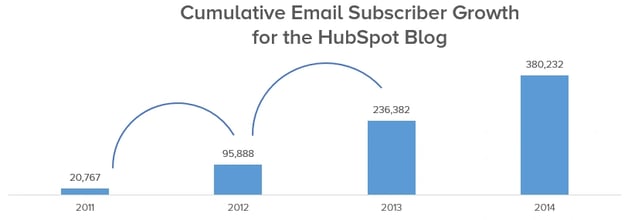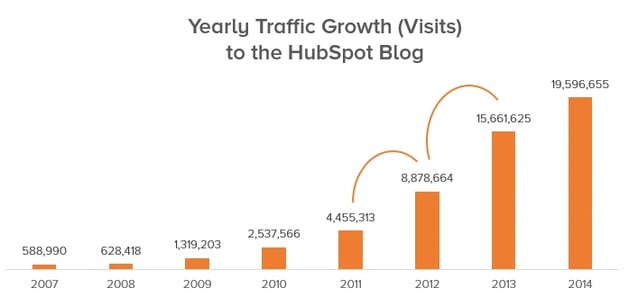"How do I grow traffic to my blog?"
It's one of the most common questions I get from people launching a new blog, and I always tell them the same thing: The key to growing blog traffic is actually to focus on growing subscribers.
On the HubSpot blogging team, we found that investing in the growth of your email subscriber base is critical to growing and scaling traffic to your blog -- whether it's in its infancy, or it's been around for years. We've even blogged about it once before. But even though we've always had anecdotal evidence that more subscribers leads to more traffic, I wanted some actual data to back it up.
So I pulled traffic and subscriber data for the HubSpot Blog over the past several years to see how those numbers correlate. Check out what I found:

(Unfortunately, we don't have subscriber data from the years prior to 2011.)

What's Up With Those Big Bumps in 2012 and 2013?
Here's what happened: Near the end of 2012, we started adding opt-in check boxes to the lead capture forms on our landing pages to give people the opportunity to subscribe to our blog. In other words, if people filled out a form on a HubSpot landing page to get one of our gated offers (like an ebook), they could also opt in to receive emails about new content on the HubSpot Blog.

This was HUGE for us. In fact, by adding these subscribe check boxes to a bunch of our landing pages, we doubled our email subscribers in just three months' time. It worked!
By the end of 2013, we had added the blog subscribe check box to all of HubSpot's landing pages for marketing-related offers, which enabled us to more than double our number of blog email subscribers from 2012 to 2013 – an increase of 147%.
And as you can see from the charts above, traffic grew right along with it.
Of course, it's always worth noting that correlation doesn't necessarily mean causation. And with a blog, performance can be impacted by a whole slew of variables like publishing frequency and quality, timing, subject matter, and usability that are practically impossible to isolate. This means it's even more difficult to determine causation. But this data is pretty convincing, and that's why growing subscribers is the one of the best pieces of advice I can give to people who are trying to grow traffic to their blog.
Why Do More Subscribers Lead to More Traffic?
As you may already know, one of the biggest benefits of blogging is its long-term ROI. That's because new blog posts don't disappear the day after you publish them. Thanks to the beauty of search engines (and social networks), those new posts can get rediscovered days, weeks, months, even years after they were originally published. Which means that over time, the more posts you publish, the more opportunities you're creating to rank well in search engines and drive ongoing, sustainable traffic to your website.
In fact, about 75% of the traffic and 90% of the leads we generate from the HubSpot Blog each month come from blog posts that weren't published that month. That's right -- old content is responsible for the lion's share of our blog's results every month.
The thing is, it takes time for your blog to accumulate a critical mass of content and search authority that leads to sustainable traffic from organic search ... and a new(er) blog doesn't have that yet. But that initial traffic needs to come from somewhere, right?
This is where subscribers come in. They can provide that initial surge of traffic to the new blog posts you publish, which ultimately propels those posts' long-term success -- in addition to your blog's overall long-term success.
Here's How It Works
You publish a new post and send an email to your subscribers to notify them. That traffic you get from your email subscribers provides an initial base of traffic to your new blog content. While your email subscriber base is mostly made up of repeat visitors, what's great about it is that your subscribers are the people who come back to your blog time and time again, making them some of your blog's biggest fans and content evangelists.
So that initial surge of traffic from those subscribers leads to social shares, inbound links, and even more views by brand new visitors, all of which helps that content (and other content on your blog) rank in search engines ... which translates into sustainable organic search traffic growth over time.
Here's some sample data from a real post on the HubSpot Blog, which was published back in March. The chart below shows the breakdown of the initial traffic the post generated in the first few days after it was published. 73% of the initial traffic this post generated came from our email subscribers -- and this is typical for any new post we publish on our blog.

The chart below shows what has happened to this post in the longer term. While email subscriber traffic was largely responsible for the initial traffic surge, this post still generates a ton of monthly traffic, and it's mostly from organic search.

That's because that initial surge of email traffic led to social shares, inbound links, and even more views that helped it to rank well in organic search for some highly searched keywords this post was originally optimized for.
Make Subscriber Growth an Ongoing Priority
While focusing on subscriber growth is critical for blogs just starting out, it can help drive ongoing blog growth for more mature blogs as well. It's simple: The more subscribers you have, the greater your reach, and the more potential you have for generating more traffic from new visitors. In fact, the HubSpot Blog has been around since 2006, and subscriber growth is still one of our team's main goals.
This post covers the "why," but if you want some tactical advice about how to actually go about growing your blog subscribers and traffic, check out these additional resources:
.png?width=112&height=112&name=Image%20Hackathon%20%E2%80%93%20Horizontal%20(67).png)


![19 Types of Blogs that Make Money in 2025 [+Examples]](https://53.fs1.hubspotusercontent-na1.net/hubfs/53/blogs-Jan-05-2024-05-12-25-3281-PM.png)



![Compounding Blog Posts: The Best Way to Grow Your Blog's Traffic [New Data]](https://53.fs1.hubspotusercontent-na1.net/hubfs/53/00-Blog_Thinkstock_Images/compounding-blog-posts.png)
![12 Ways to Get More Blog Subscribers [Infographic]](https://53.fs1.hubspotusercontent-na1.net/hub/53/file-1564803527-png/Blog-Related_Images/How_To_Get_More_Blog_Subscribers.png)
